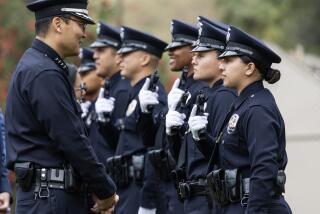Deployment of LAPD Officers
- Share via
The article, “DARE’s Results Prove Difficult to Measure” (Jan. 19), was headlined not only by one of the most erroneous statements I have ever seen published, but also sent an inaccurate message to your readers not familiar with the DARE program.
The DARE program is not just about saying “no” to drugs. The 17-week core curriculum teaches kids to never take drugs by helping them build their self-esteem, manage stress, foresee behavioral consequences, resist pro-drug media messages and identify alternatives to drug use.
The 1987-88 study by the Evaluation and Training Institute to which you referred in fact showed substantial statistical differences between DARE and non-DARE students in their use of “gateway” drugs--inhalants, beer/liquor/wine and tobacco--those drugs children are most likely to first be exposed to and presented to experiment with.
In 1990, the California Department of Education reported that substance abuse in the average Los Angeles city school had dropped 53% and not only credited the DARE program but also recommended that a similar approach be applied to other crime areas.
In addition, the article questions the need for police officers to teach the DARE program. It has been shown repeatedly that students are generally much more sophisticated about substance abuse than their classroom teachers and that police officers, because of their years of direct experience with the ruined lives and crimes caused by substance abuse, have infinitely more credibility with students.
I don’t see how anyone, with accurate information, could misjudge the DARE program the way The Times did.
NATHAN SHAPELL
DARE President
Los Angeles
More to Read
Sign up for Essential California
The most important California stories and recommendations in your inbox every morning.
You may occasionally receive promotional content from the Los Angeles Times.










